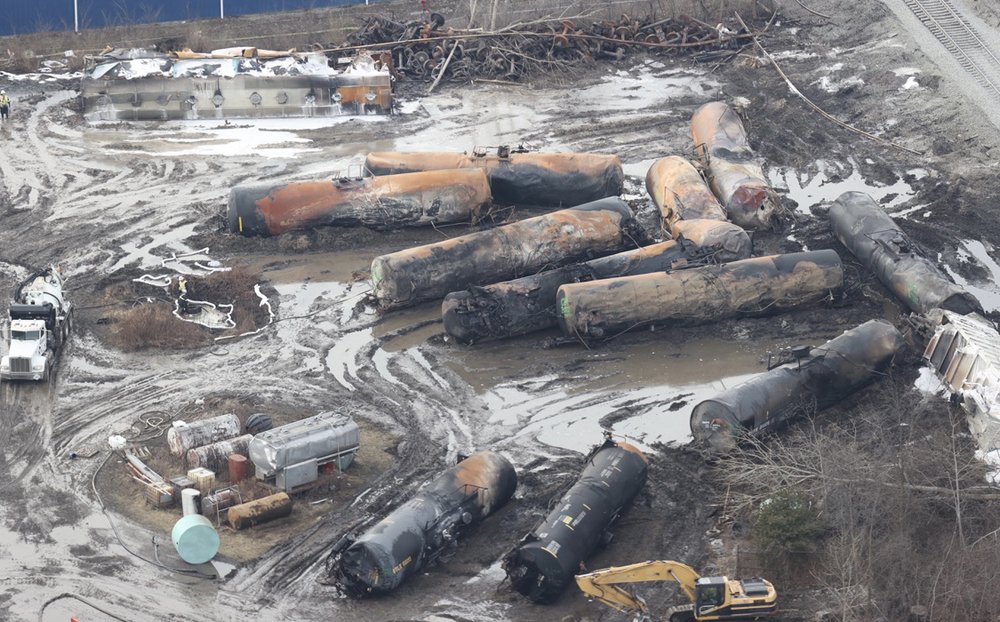After returning to their homes this week, some East Palestine, Ohio, residents claim to have suffered rashes, sore throats, nausea, and headaches. These neighbors are concerned that these new ailments may be caused by toxins discharged from a train crash two weeks ago.
The event on February 3 resulted in a significant fire, which prompted authorities to order the evacuation of hundreds of nearby residents out of concern that a dangerous, highly combustible substance might catch fire. Toxic vinyl chloride gas was evacuated and burned to avoid a potentially fatal explosion, sending a plume of black smoke over the town for several days.
As people’ resentment grows, the EPA administrator promises to hold the train corporation accountable for the Ohio toxic train accident.
According to the US Environmental Protection Agency, other chemicals at the site that are of concern include 2-ethylhexyl acrylate, butyl acrylate, ethylene glycol monobutyl ether acetate, phosgene, and hydrogen chloride, which are generated as vinyl chloride breaks down. As all of these compounds degrade or interact with other elements in the environment, a stew of potential poisons results.
Even MORE proof that the EPA is LYING to the people of East Palestine.
— Nick Sortor (@nicksortor) February 16, 2023
THIS WATER IS INSANELY CONTAMINATED. pic.twitter.com/rNlNxxBTDd
The residents of East Palestine were granted the all-clear to return to their homes on February 8 after air monitoring revealed no elevated levels of dangerous chemicals there.
Further testing of the indoor air in around 500 residences, according to officials, has not revealed any dangers. Despite ongoing testing of the area’s rivers, streams, and private wells, tests of the tap water from the municipal system did not reveal any pollutants at levels that would be harmful to human health.
Some locals, who claim something is making them ill even though officials can’t discover it, are unconvinced by these test results.
“I can’t put my family’s health at jeopardy.” We came to the conclusion that we couldn’t raise our children here when we returned on the 10th, according to Amanda Greathouse. There was an offensive odor that persisted for a long time and “reminded me of hair perming solution.”
Greathouse claimed that she had been back at their home, a block or so from the scene of the incident, for 30 minutes when she experienced nausea and a rash.
The mother of two preschool-aged children, Greathouse, said, “When we left, I had a rash on my skin on my arm, and my eyes were burning for a few days after that.
Since the derailment, she and her husband have only gone back to their house twice to pick up clothing and documentation.

Greathouse complained that the chemical smell made her queasy. “All I wanted to do was grab my essentials and head out. I only brought a few articles of clothing because I was hesitant to put them on my children because even the clothes smelled chemically.
Since the incident, she claims she has also kept her kids out of preschool. Although the teacher of her son’s class assured her that pupils were only drinking bottled water, she is still concerned about other potential sources of contamination.
“I truly enjoy the teachers my son has at the preschool they attend, so I don’t want to remove him from there, but I’m still afraid. Even some teachers have voiced their worries about the air quality, according to Greathouse.
“We rent our home, which is a great blessing. I never imagined saying that. Although I feel terrible for my landlord, I simply cannot put my family’s health at risk.
While neighbors’ safety fears boil, the federal government is sending medical specialists to the Ohio hazardous train disaster site.
The US Department of Health and Human Services has agreed to send medical specialists, according to Ohio Governor Mike DeWine, and they should start arriving early next week to support a clinic for patients.
“We are aware that the science suggests that this water and the air are both safe. But we also understand fully why East Palestine inhabitants are worried,” he remarked on Friday.
DeWine stated that he intends to establish a clinic where HHS representatives and others will respond to inquiries, assess symptoms, and offer medical expertise.
According to a CDC spokesperson who asked to remain anonymous because they weren’t authorized to discuss the specifics, the Agency for Toxic Substances and Disease Registry, a division of the US Centers for Disease Control and Prevention, also states that it anticipates having a team on the scene Monday. The team will carry out an Assessment of Chemical Exposure research, which examines how a chemical release affects individuals and the surrounding area.
Although experts say it’s very difficult to link chemical exposures to health effects, the volatile organic compounds released by the controlled explosion may cause symptoms like headache, sore throat, and nose and eye irritation that some East Palestine residents have reported.
Erin Haynes, chair of the University of Kentucky’s Department of Epidemiology and Environmental Health, describes this as a significant challenge.
Residents of Ohio are experiencing the storyline of a movie they helped create after a train derails.
The community is currently exposed to a variety of volatile organic compounds derived from petroleum, so Haynes speculated that it might not be just one but a combination of them.

To begin a study in East Palestine to help residents better understand their chemical exposures in air, water, and soil, Haynes, who has experience researching toxic exposures in communities, says she is requesting approval from her university’s Institutional Review Board.
They require all the assistance they can get, she declared. “A huge emergency has occurred. This is a terrible catastrophe. They require every bit of help we humans can muster.
“The rashes may very well be the indication of a hazardous exposure,” she stated.
DeSanzo, who lives about half a mile from the derailment with her two elementary-aged children, questioned, “How safe is it, really?” “It’s not all in these people’s heads that they’re getting rashes, conjunctivitis, pinkeye from chemicals,” one person claimed.
“When you remain here, you have a sore throat. The air smells bad here.
Residents gather in a meeting a week after the hazardous Ohio train crash to voice their concerns about safety.
After the derailment, DeSanzo and her children fled to Pennsylvania, just across the state line, where her uncle owned an unoccupied duplex. On the couch and the floor, they slept.
DeSanzo claims that when she returned home this week, she cleaned their clothes and sheets, changed the furnace filter, and aired out the house. She claims that despite this, they recently visited a nearby urgent care facility because her children were coughing and “our throats were sore.”
Strep throat tests came back negative. The pediatrician advised DeSanzo that the children should take cough medicine and that it was likely the chemicals that were to blame.
According to DeSanzo, the doctor suggested the patient to phone poison control and visit the nearby hospital for a blood test after stating that she has treated several East Palestine residents with such symptoms. She still hasn’t had her blood tested.
A spokeswoman for Salem Regional Medical Center, which operates the clinic DeSanzo visited, Debbie Pietrzak, said that a small number of locals with symptoms including sore throats and respiratory issues have been treated there. Less than 10 patients from East Palestine had been seen in the hospital’s emergency room, according to her.
We are collaborating closely with the County’s Health Department and other local, state, and federal organizations, which are keeping an eye on the issue, said Pietrzak in an email. “Our facilities and primary care providers stand ready to support anyone who is seeking medical attention,” he said.
East Palestine locals are also calling the state’s poison control facilities, according to Natalie Rine, a pharmacist who oversees the Central Ohio Poison Center. Toxicology-trained professionals who staff the help lines can offer assistance if chemicals pose a health risk.
DeSanzo claims that despite wanting to leave, she cannot. Her monthly mortgage is about $400, which is significantly less than that of other nearby homes that are located further away from the scene of the accident.
I am paid $14 per hour. Where do I go from here? She spoke. I don’t want my kids and to be here right now.
Residents said they can’t risk returning despite assurances.
Since April, Ayla and Tyler Antoniazzi and their two daughters have resided in East Palestine. They weren’t certain about leaving after the train crash, but now they’re thinking about it, according to Ayla.
The day after the evacuation order was lifted, the Antoniazzi family went back to their home, which was less than a mile from the scene of the accident.
“Before bringing my kids back home, I washed all the linen and a bunch of clothes, cleaned surfaces and aired the house out,” Ayla said. “But the next day when they woke up, they weren’t themselves. My eldest’s face was covered in a rash. The youngest also performed, but not as poorly. The 2-year-old was gripping her eye and whining about how much it hurt. Since she was so drowsy, I drove them back to my parents’ house.
In order for the couple to ensure that their home is secure, Ayla says her girls are living with her parents in Leetonia, roughly 20 minutes west of East Palestine.
She claimed that although the children’s symptoms improved in Leetonia, one of them had a new rash on February 13 after going back to school in East Palestine.
“I did let my 4-year-old go back to preschool at East Palestine Elementary School. Ayla stated, “I pulled her back out after she went back for two days and had another rash on her hands and started complaining of itching.
Next week, Ayla has planned a visit with her girls to the doctor to talk about their symptoms and any testing.
According to allergist Dr. Kari Nadeau, who also serves as the department’s chair at Harvard’s TH Chan School of Public Health, doing that is the appropriate thing to do.
According to Nadeau, headaches, sore throats, and rashes can be medical indicators of chemical sensitivity.
People with high chemical sensitivity can experience the effects before a monitor does, according to Nadeau. “Chemical sensitivities do not have a good diagnostic mechanism. Rashes and other clinical signs are the basis of a lot of it.
Nadeau and other environmental health specialists advise those who are experiencing symptoms to visit a doctor, firstly for medical attention but also to document their case.
“This really helps clinicians get together with organizations like the CDC and do a little bit more fact-finding if there is a cluster, or if there is a group of people who all of a sudden have complained about a rash or given symptoms,” she added.




